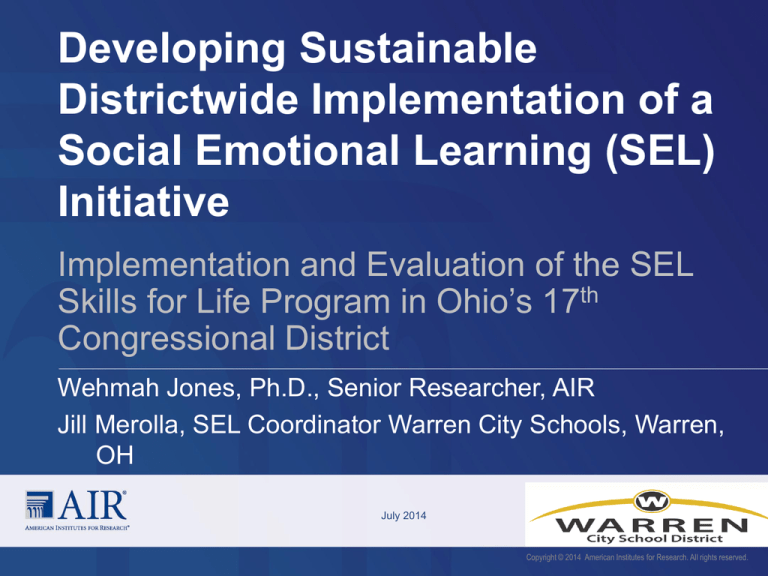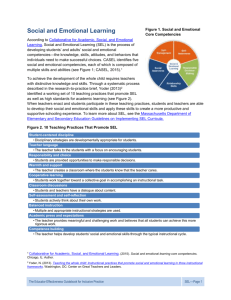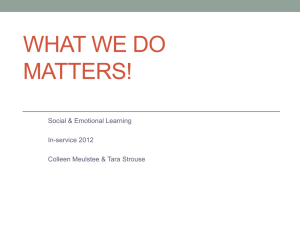
Developing Sustainable
Districtwide Implementation of a
Social Emotional Learning (SEL)
Initiative
Implementation and Evaluation of the SEL
Skills for Life Program in Ohio’s 17th
Congressional District
Wehmah Jones, Ph.D., Senior Researcher, AIR
Jill Merolla, SEL Coordinator Warren City Schools, Warren,
OH
July 2014
Copyright © 2014 American Institutes for Research. All rights reserved.
Objectives
Objective One: Become familiar with SEL and its role in promoting
positive youth development and academic outcomes
Objective Two: Become familiar with the components of the Skills for
Life and its methods for fostering social emotional health in young
people.
Objective Three: Be able to identify the ingredients for success in
implementing a research-based Social Emotional Learning program in a
public school setting
Objective Four: Recognize the potential barriers for implementation
and possible funding streams for financial support.
2
Emotional Intelligence Defined
“The capacity for
recognizing our own feelings
and those of others, for motivating
ourselves, for managing emotions
well in ourselves and in our
relationships.”
Daniel Goleman
The Feeling-Learning Connection
Without access to our memory we cannot
learn.
Learning
Memory
In order to remember, we need to be able to
focus our attention. When we’re focused
we’re in a state of “relaxed alertness” and
we’re ready to learn.
Our feelings determine whether we can focus
or not. When we’re emotionally flooded and
don’t have a chance to empty or express
them, our emotions hijack us and block our
capacity to focus.
Focus
Feelings
Our feelings determine our capacity to learn.
What is Social Emotional Learning?
Self
Self-awareness
Other
Decision-Making
Social-awareness
Responsible
Decision-making
Relationship Skills
Self-management
Source: CASEL
5
How Does SEL Work?
SEL is an evidence-based strategy that integrates the intellectual,
emotional an social facets of learning. It works through two
related approaches:
Positive
Explicit
School
SEL Skills
Climate
+
Instruction
=
Positive
Results for
Children
Source: SEL and Academics: Research Brief, Collaborative for Academic, Social and Emotional Learning, 2007.
6
What Does the Research Tell Us?
Meta-analysis of over 200 studies on SEL
• Quasi-experimental (Pre-Post) – 213 studies
• Randomized = 47%
• Since 1990 = 75%
• Number of students: 270,034
• Elementary (56%), middle (31%), an high school (13%)
• Urban, suburban, and rural
Source: Durlak, J. A., Weissberg, R. P., Dymnicki, A. B., Taylor, R. D., & Schellinger, K. (in press). The impact of enhancing
students’ social and emotional learning: A meta-analysis of school-based universal interventions.Child Development
7
What Does the Research Tell Us?
Benefits of SEL
•Social-emotional skills
•Improved attitudes about self, others,
and school
•Positive classroom behavior
•11 percentile-point gain on
standardized achievement tests
And Reduced Risks for Failure:
•Conduct problems
•Aggressive behavior
•Emotional distress
8
Benefits of SEL (cont.)
More high school graduates
More attending college
More employed
Better emotional and mental health
Fewer with a criminal record
Less drug selling
Less co-morbid diagnosis of substance abuse and mental
disorder
Source: Hawkins et al.
9
Benefits of SEL (cont.)
SEL teaches 21st Century Skills
•
•
•
•
•
•
•
Critical thinking and problem-solving
Ethics and social responsibility
Communication
Teamwork and collaboration
Lifelong learning and self-direction
Leadership
Global awareness
Source: Partnership for 21st Century Skills
10
Skills for Life Program
Integrates the research based SEL program – The 4R’s
with the evidenced based intervention of the work of the
Inner Resilience Program to offer:
SEL as a guiding framework for school improvement by creating the
classroom climate and explicit skills instruction.
The cultivation of the adult’s own emotional intelligence and stress
management skills as well as helping them create a calmer and more
peaceful classroom environment by teaching young people practices
that will improve their attention, manage stress, and regulate their
emotions.
11
Skills for Life Program Objectives
1. Increase the knowledge and ability of
teachers/school staff to deliver an
evidence-based SEL
curriculum/approach.
2. Promote the SEL competence of staff
through professional development.
5.
Increase the knowledge and ability
of district administrators and other
district leaders to support
districtwide SEL through training
and coaching.
6.
Build capacity of schools to
involve parents in supporting
student SEL by providing SEL
train-the-trainer workshops.
7.
Build local capacity (district and
school) to support high-quality,
sustainable SEL programming.
3. Support the launch of weekly
implementation of an evidencebased curriculum and approach.
4. Increase the knowledge and ability of
school administrators and other
school leaders to support schoolwide
SEL through training and coaching.
12
Skills for Life Evaluation
Purpose of Evaluation:
• Determine the extent to which to program met its objectives
Research Design
• Implementation and Outcome Evaluation
• Mixed-methods
Data Sources
• Training evaluation forms.
• Online surveys
• Interviews and focus groups
• Document review
13
District Context
Youngstown City Schools:
• Academic Emergency – at the start of the grant (2010-2011 school year).
• Improved its rating to Academic Watch for the 2011-2012 school year.
Warren City Schools:
• Academic Watch
• Improved its rating to Continuous Improvement for the 2011-2012 school
year.
Both Districts:
• Ranked among the lowest in student performance on state tests (based on
data from the 2011-2012 school year)
• Experienced changes in district and school leadership
14
Key Findings: SEL Knowledge
Participants demonstrated
statistically significant
improvement in their knowledge
of training topics after one year of
implementation.
The greatest gains in knowledge
occurred in topics related to the
improvement of social emotional
competencies.
Knowledge of Training
Topics
5
4
Baseline
3
Follow-up
2
1
Cohort 1*
Cohort 2*
15
Key Findings: SEL Knowledge
Both cohorts increased their
perceptions of the positive
relationship between SEL
and academic achievement.
• This increase was only statistically
significant among Cohort 1
participants.
SEL and Acaemic
Achievement
5
4.5
Baseline
4
Follow-up
3.5
3
Cohort 1*
Cohort 2
16
Key Findings: SEL Competence
SEL Efficacy
Classroom Behavior
Management Efficacy
Mindfulness
5.0
5
5
4.5
4.5
4.5
Baseline
4.0
Baseline
4
Follow-up
3.5
3
3.0
Cohort 1*
Cohort 2*
Follow-up
Follow-up
3.5
3.5
Baseline
4
3
Cohort 1*
Cohort 2*
Cohort 1
Cohort 2*
School staff significantly increased their social and emotional learning efficacy
and became more mindful about their interactions with students
Cohort 2 participants reported statistically significant change in their classroom
behavior management efficacy after the first year of implementation.
17
Key Findings: Implementation and
Student Outcomes
Skills for Life was implemented at least once a week in
most classrooms
Teachers reported positive changes in student behavior.
•
•
•
•
Improved peer interactions
Improved classroom climate
Increased student awareness of their own feelings
Independent problem solving
18
Key Findings: Capacity Building
28 school administrators were trained
• Administrator support varied by school
• Changes in leadership and academic pressures impacted the level of
administrator support
15 district administrators were trained
• District SEL liaisons were identified as a primary source of district-level
support and their involvement was key in encouraging participation and
support at the school level.
Schools developed the capacity to implement parent SEL
workshops
• By the end of Year 2 nearly 300 parents had attended at least one workshop
19
Key Findings: Capacity Building
SEL school liaisons were key in leading SEL work in the schools
and helping schools to promote schoolwide expansion of some
program components.
SEL steering committees were established in each school and
made the most progress toward developing a shared schoolwide
vision for social and emotional learning.
• Committees had inconsistent participation and ongoing changes in the
composition of some committees may have had an impact on their progress.
Districts and schools demonstrated a commitment to sustaining SEL
programming beyond the life of the grant.
20
Warren City Schools Implementation
Schedule
2010-2011 4 day training for 80 PK-2 teachers, counselors,
literacy coaches, and principals funded by DOE grant and
Title I funding.
2011-2012 4 day training for 58 3rd-5th grade teachers and
counselors DOE Title I Funding
2012-2013 2 day training for new PK-5 teachers, 3 hours of
training for 6th-8th grade staff, Principal Academy-Novo
Foundation and Title I
2013-2014 4 day training for new PK-6th Staff –Novo
Foundation and Title I funding
6 Hours Mandatory PD for all PK-12 staff- General Fund
On going SEL Support
Round-ups
2 hour meetings to
discuss SEL
Implementation and
Adult Mindfulness
Principal Academy
6 hour PD on
Leadership and SEL
emphasis on staff
support
Peace in Family
Training for
Counselors and
School Liaisons
12 hour class to
work with families
SEL Fridays
30 minute weekly
sessions to support
the heart and
pleasures of
teaching
In Class Coaching
1 hour sessions 30
in class, 30 out of
class consultation
Adult SEL Retreat
Days
6 hour days for rest
and reflection for
Adult educators
Ingredients for SEL Implementation
Success
Respecting the emotional Giving time to practice
work of teachers.
teaching skills ahead of
time and on-going support
Teaching SEL skills for
from consultants and
teachers first and giving
school SEL leaders.
time for experiential
learning for adults.
Developing in school
leaders who can assist in
Allowing time during
on site coaching and
trainings to talk with
colleagues about teaching materials management.
and SEL.
Warren City Schools Next Steps…
Adding 4 R’s to 7th grade for 2014-2015.
Piloting “Circles” an SEL curriculum created by
Morningside Center For Teaching Social Responsibility to
build relationships and prevent bullying in Middle Schools
and High School.
Design a HS transition course for 8th and 9th grade
including SEL and College/Career Readiness components.
Coaching and classroom visits by staff developers
Administrator Component
Strategies for Coordinated
District/School SEL Promotion
Select an evidence-based SEL curriculum
Teach, model, and reinforce skills throughout the day
Create opportunities to practice SEL skills in a variety of
settings/situations
Infuse SEL concepts and skill-building into core academics
Coordinate with student support services, extracurricular activities,
out-of-school programs
Partner with families and the community
28
Academic, Social, and Emotional Learning Act
Introduced as HR 4223 in December 2009 by Congressman Dale E. Kildee (DMI), Congresswoman Judy Biggert (R-IL) and Congressman Tim Ryan (D-OH)
1. Will reach more children with evidencebased Social and Emotional Learning
Award competitive grants to states and school
districts to develop and implement social and
emotional learning
2. Will measure and broadly share results
3. Will support teachers, school districts and
states
Establish a National SEL Technical Assistance
and Training Center to provide high quality
information, professional development, and
research-based tools
Key Strategy: HR 4223 must be included in reauthorization of the
Elementary & Secondary Education Act (ESEA), now underway.
Wehmah Jones
202-403-5663
wjones@air.org
Jill Merolla
330-841-2321 ext. 7220
Jill.Merolla@neomin.org
1000 Thomas Jefferson Street NW
Washington, DC 20007
General Information: 202-403-5000
TTY: 887-334-3499
www.air.org
105 High St.
Warren, Ohio 44481
30








